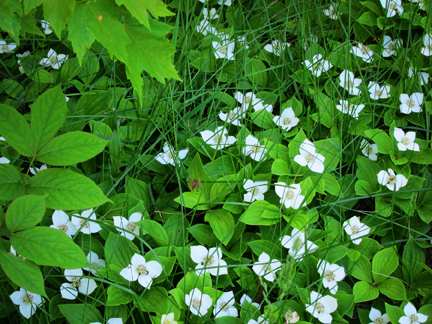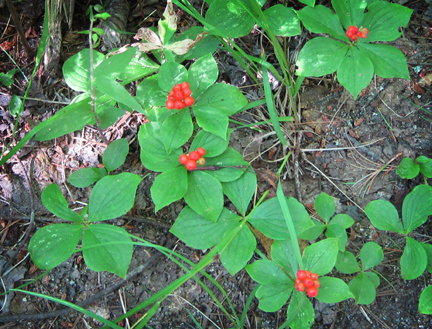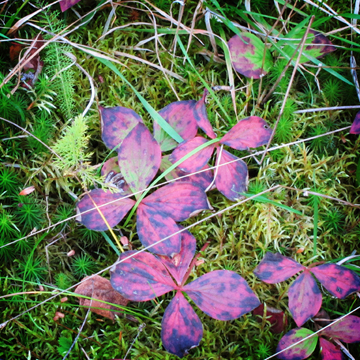Adirondack Wildflowers:
Bunchberry (Cornus canadensis)
 Adirondack Wildflowers: Bunchberry (Cornus canadensis) blooming at the Paul Smiths VIC
Adirondack Wildflowers: Bunchberry (Cornus canadensis) blooming at the Paul Smiths VIC
| This page is no longer being updated. For an updated and expanded version of this material, see: Bunchberry (Cornus canadensis). |
The slender 3-6 in. stalks of this perennial, woodland ground cover are topped by a whorl of oval, pointed leaves above which rises a white to greenish, dogwood blossom. Erect stems grow in extensive low patches, with 1 whorl of leaves at top and, just above, a cluster of tiny greenish flowers surrounded by 4 ovate white or pinkish bracts. The flower cluster resembles a single large flower held on a short stalk above leaves. A cluster of bright red berries follows. The leaves, which are dark-green and shiny in summer, become wine-red in fall. It spreads by underground stems.
 Adirondack Wildflowers: Bunchberry fruiting in late July at the Paul Smiths VIC
Adirondack Wildflowers: Bunchberry fruiting in late July at the Paul Smiths VIC
The genus cornus is Latin for a horn. This plant is also called bunchberry dogwood, dwarf dogwood, Canadian bunchberry, dogwood bunchberry, and dwarf cornel. It is threatened or endangered in Illinois, Indiana, Iowa, Maryland, and Ohio.
 Among
the smallest of a genus of mostly shrubs and trees, Bunchberry
makes an excellent ground cover in the moist woodland garden and
is equally attractive in flower or fruit. Its natural range extends
from Greenland across northern North America to northeast Asia.
In the continental US, it is limited mostly to mountainous regions.
This showy wildflower and Northern Dwarf Cornel (C. suecica) of
the northern forests are the only herbs in the dogwood group,
the other members being trees or shrubs.
Among
the smallest of a genus of mostly shrubs and trees, Bunchberry
makes an excellent ground cover in the moist woodland garden and
is equally attractive in flower or fruit. Its natural range extends
from Greenland across northern North America to northeast Asia.
In the continental US, it is limited mostly to mountainous regions.
This showy wildflower and Northern Dwarf Cornel (C. suecica) of
the northern forests are the only herbs in the dogwood group,
the other members being trees or shrubs.
Bunchberry grows abundantly around the Paul Smiths VIC parking lot, along the path to the Visitor Center Building and along many of the trails, including the Barnum Brook Trail and the Boreal Life Trail. It usually blooms in early summer (late May and early June) and fruits in late July. The folliage turns a lovely wine red in late September.
References:
- Lady Bird Johnson Wildflower Center. Native Plant Database.
- United States Department of Agriculture. Plants Database
- Enature. Wildflower Field Guide
